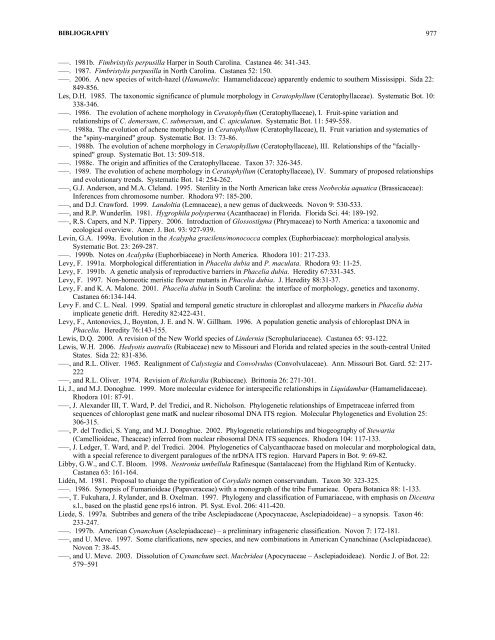Part 7 - UNC Herbarium
Part 7 - UNC Herbarium
Part 7 - UNC Herbarium
You also want an ePaper? Increase the reach of your titles
YUMPU automatically turns print PDFs into web optimized ePapers that Google loves.
BIBLIOGRAPHY 977<br />
–––. 1981b. Fimbristylis perpusilla Harper in South Carolina. Castanea 46: 341-343.<br />
–––. 1987. Fimbristylis perpusilla in North Carolina. Castanea 52: 150.<br />
–––. 2006. A new species of witch-hazel (Hamamelis: Hamamelidaceae) apparently endemic to southern Mississippi. Sida 22:<br />
849-856.<br />
Les, D.H. 1985. The taxonomic significance of plumule morphology in Ceratophyllum (Ceratophyllaceae). Systematic Bot. 10:<br />
338-346.<br />
–––. 1986. The evolution of achene morphology in Ceratophyllum (Ceratophyllaceae), I. Fruit-spine variation and<br />
relationships of C. demersum, C. submersum, and C. apiculatum. Systematic Bot. 11: 549-558.<br />
–––. 1988a. The evolution of achene morphology in Ceratophyllum (Ceratophyllaceae), II. Fruit variation and systematics of<br />
the "spiny-margined" group. Systematic Bot. 13: 73-86.<br />
–––. 1988b. The evolution of achene morphology in Ceratophyllum (Ceratophyllaceae), III. Relationships of the "faciallyspined"<br />
group. Systematic Bot. 13: 509-518.<br />
–––. 1988c. The origin and affinities of the Ceratophyllaceae. Taxon 37: 326-345.<br />
–––. 1989. The evolution of achene morphology in Ceratophyllum (Ceratophyllaceae), IV. Summary of proposed relationships<br />
and evolutionary trends. Systematic Bot. 14: 254-262.<br />
–––, G.J. Anderson, and M.A. Cleland. 1995. Sterility in the North American lake cress Neobeckia aquatica (Brassicaceae):<br />
Inferences from chromosome number. Rhodora 97: 185-200.<br />
–––, and D.J. Crawford. 1999. Landoltia (Lemnaceae), a new genus of duckweeds. Novon 9: 530-533.<br />
–––, and R.P. Wunderlin. 1981. Hygrophila polysperma (Acanthaceae) in Florida. Florida Sci. 44: 189-192.<br />
–––, R.S. Capers, and N.P. Tippery. 2006. Introduction of Glossostigma (Phrymaceae) to North America: a taxonomic and<br />
ecological overview. Amer. J. Bot. 93: 927-939.<br />
Levin, G.A. 1999a. Evolution in the Acalypha gracilens/monococca complex (Euphorbiaceae): morphological analysis.<br />
Systematic Bot. 23: 269-287.<br />
–––. 1999b. Notes on Acalypha (Euphorbiaceae) in North America. Rhodora 101: 217-233.<br />
Levy, F. 1991a. Morphological differentiation in Phacelia dubia and P. maculata. Rhodora 93: 11-25.<br />
Levy, F. 1991b. A genetic analysis of reproductive barriers in Phacelia dubia. Heredity 67:331-345.<br />
Levy, F. 1997. Non-homeotic meristic flower mutants in Phacelia dubia. J. Heredity 88:31-37.<br />
Levy, F. and K. A. Malone. 2001. Phacelia dubia in South Carolina: the interface of morphology, genetics and taxonomy.<br />
Castanea 66:134-144.<br />
Levy F. and C. L. Neal. 1999. Spatial and temporal genetic structure in chloroplast and allozyme markers in Phacelia dubia<br />
implicate genetic drift. Heredity 82:422-431.<br />
Levy, F., Antonovics, J., Boynton, J. E. and N. W. Gillham. 1996. A population genetic analysis of chloroplast DNA in<br />
Phacelia. Heredity 76:143-155.<br />
Lewis, D.Q. 2000. A revision of the New World species of Lindernia (Scrophulariaceae). Castanea 65: 93-122.<br />
Lewis, W.H. 2006. Hedyotis australis (Rubiaceae) new to Missouri and Florida and related species in the south-central United<br />
States. Sida 22: 831-836.<br />
–––, and R.L. Oliver. 1965. Realignment of Calystegia and Convolvulus (Convolvulaceae). Ann. Missouri Bot. Gard. 52: 217-<br />
222<br />
–––, and R.L. Oliver. 1974. Revision of Richardia (Rubiaceae). Brittonia 26: 271-301.<br />
Li, J., and M.J. Donoghue. 1999. More molecular evidence for interspecific relationships in Liquidambar (Hamamelidaceae).<br />
Rhodora 101: 87-91.<br />
–––, J. Alexander III, T. Ward, P. del Tredici, and R. Nicholson. Phylogenetic relationships of Empetraceae inferred from<br />
sequences of chloroplast gene matK and nuclear ribosomal DNA ITS region. Molecular Phylogenetics and Evolution 25:<br />
306-315.<br />
–––, P. del Tredici, S. Yang, and M.J. Donoghue. 2002. Phylogenetic relationships and biogeography of Stewartia<br />
(Camellioideae, Theaceae) inferred from nuclear ribosomal DNA ITS sequences. Rhodora 104: 117-133.<br />
–––, J. Ledger, T. Ward, and P. del Tredici. 2004. Phylogenetics of Calycanthaceae based on molecular and morphological data,<br />
with a special reference to divergent paralogues of the nrDNA ITS region. Harvard Papers in Bot. 9: 69-82.<br />
Libby, G.W., and C.T. Bloom. 1998. Nestronia umbellula Rafinesque (Santalaceae) from the Highland Rim of Kentucky.<br />
Castanea 63: 161-164.<br />
Lidén, M. 1981. Proposal to change the typification of Corydalis nomen conservandum. Taxon 30: 323-325.<br />
–––. 1986. Synopsis of Fumarioideae (Papaveraceae) with a monograph of the tribe Fumarieae. Opera Botanica 88: 1-133.<br />
–––, T. Fukuhara, J. Rylander, and B. Oxelman. 1997. Phylogeny and classification of Fumariaceae, with emphasis on Dicentra<br />
s.l., based on the plastid gene rps16 intron. Pl. Syst. Evol. 206: 411-420.<br />
Liede, S. 1997a. Subtribes and genera of the tribe Asclepiadaceae (Apocynaceae, Asclepiadoideae) – a synopsis. Taxon 46:<br />
233-247.<br />
–––. 1997b. American Cynanchum (Asclepiadaceae) – a preliminary infrageneric classification. Novon 7: 172-181.<br />
–––, and U. Meve. 1997. Some clarifications, new species, and new combinations in American Cynanchinae (Asclepiadaceae).<br />
Novon 7: 38-45.<br />
–––, and U. Meve. 2003. Dissolution of Cynanchum sect. Macbridea (Apocynaceae – Asclepiadoideae). Nordic J. of Bot. 22:<br />
579–591













